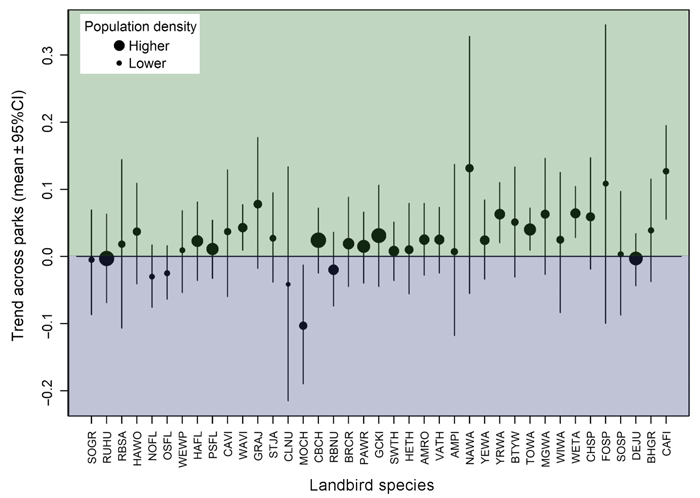| Follow @co2science |
Paper Reviewed
Ray, C., Saracco, J.F., Holmgren, M.L., Wilkerson, R.L., Siegel, R.B., Jenkins, K.J., Ransom, J.I., Happe, P.J., Boetsch, J.R. and Huff, M.H. 2017. Recent stability of resident and migratory landbird populations in National Parks of the Pacific Northwest. Ecosphere 8: e01902, doi:10.1002/ecs2.1902.
Ray et al. (2017) introduce their work by writing that monitoring bird population statistics in montane parks "is especially urgent because mountain habitats are among the most immediately susceptible to [the] effects of climate change," citing the most recent assessment reports from the United Nations Intergovernmental Panel on Climate Change. Thus, they designed and carried out an experiment to assess the population stability of resident and migratory landbirds in three National Parks in the Pacific Northwest of the USA (Mount Rainier, North Cascades and Olympic National Parks).
In accomplishing their design, more specifically, the team of ten researchers conducted a total of 8404 point-count surveys at 3177 distinct survey point locations across the three parks during the breeding seasons of 2005-2014. From those surveys, 39 species (24 migratory and 15 "residents" that overwinter in the parks) were identified for population stability analyses.
These statistical tests revealed, in the words of Ray et al., that "all but one species were either stable or increasing across the sampled points in the three parks" throughout the period of study (see Figure 1 below). Furthermore, the authors say they "found little evidence for upslope range shifts across the sampled region," adding that "no species increased at higher elevations while declining at lower elevations."
Ray et al. further note that the predominately stable trends in breeding landbirds they found are in line with trends estimated from other breeding bird survey data obtained throughout the western United States. Consequently, they conclude that "a large fraction of bird species breeding in the United States [has] been affected positively by recent climate change." And this positive news stands in stark contrast to alarmist projections of bird population declines in response to climate change.

Figure 1. Trends in population density for 39 landbird species during 2005-2014, estimated from point-counts in Mount Rainier, North Cascades, and Olympic National Parks. Species codes on the x-axis are defined in the author's Table 3. Green shading indicates positive trends in population density and blue-gray shading indicates negative trends. Dot sizes indicate the relative density estimated for each species and vertical lines represent 95% confidence intervals. Adapted from Ray et al. (2017).




